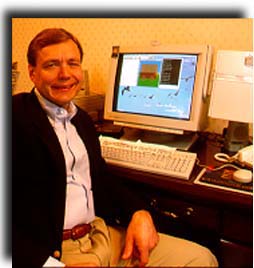| VOLUME 29, NUMBER 12 | THURSDAY, NOVEMBER 13, 1997 |
Writing the new math standards
It's new challenge for Clements of prize-winning 'Turtle Math' software
By BRENT CUNNINGHAM
Despite being recently named to one of the writing teams for "Standards 2000," a National Council of Teachers of Mathematics (NCTM) project, Douglas H. Clements may still be most commonly associated with a little black turtle that draws triangles and rectangles.
Clements met this summer for the first time with the "Standards 2000" group. Its goal is to revise and clarify the original NCTM "Standards" document, which has had a wide-ranging impact on the national math curricula and textbook production over the past eight years.
Since the new project is still in its early stages, Clements is reluctant to speculate as to exactly how it plans to revise the "Standards" document. But "Turtle Math" is a good key to the kinds of ideas he will bring to the project.
An interactive computer program redesigned from the "Logo" program by Clements and Julie Sarama of Wayne State University, "Turtle Math" is used in elementary schools across the United States. Like "Logo," the game begins with a black turtle on a white screen. Using simple commands for distance and turns in degrees, children can program the turtle's path, creating and manipulating the geometric shapes it leaves in its wake.
Among other innovations, Clements and Sarama added options to the "Logo" tool bar that helped strengthen connections between the child's program and the drawn figure.
"'Logo' was simplicity itself from the kids' point of view," said Clements, "and that was important. You want the kids to make the mental actions, to create interesting stuff, and not have the program designers doing it for them. It's part of the whole structural problem in education: most of us teach what we're taught. Much of the education software is still word-problems-at-the-end-of-the-chapter, only now they have songs or dancing bears."
Clements sees the "dancing bears" as an extension of a "passive, viewing-oriented" culture.
"Some educational computer programs try to compete with that passive culture," he said. "I don't pretend it's easy to go against that, or that I'm always successful, but I still think people can be motivated by their own creations, the making of stuff that embodies deep mathematical ideas, rather than just making it more and more entertaining."
Along with this constructivist, kids'-eye view of mathematical learning, Clements will bring a more general philosophy of education to the "Standards 2000" project.
"It's largely about balance," he said. "On the one hand, education tries to help the individual realize their full potential and, on the other hand, it tries to help that individual become a full, participatory member of a given culture. My position is always to take both into consideration, but not to put either the practical utility of math or its aesthetic value higher than the other."
This concern for a balance, said Clements, is one of the reasons he is hesitant to comment on the "Standards 2000" project in its early stages.
"If we come out saying we never meant to abandon basic skills (in the original 'Standards' document) and we say that in the wrong way, it could be interpreted as us saying, 'We were wrong before and now we're changing our minds.' And if we continue to say it exactly the same way they might say, 'See, they aren't listening to our concerns.'
"There are all kinds of misunderstandings about the whole reform movement," he added. "People sometimes say to me, 'Well, in your system any answer is 'right.' Is that what you're saying?' And, no, not at all...but in some math problems there are multiple answers, just like in engineering and physics there are multiple answers. There are many ways to make a chair. And in math, that can be an important kind of thinking."
Part of the motivation for "Turtle Math," said Clements, was to encourage a kind of learning that "basic skills" do not always cover. "When the turtle draws the figure, it shows your ideas enacted," he said. "Instead of writing down a bunch of answers and the teacher marks you wrong, you design something, you make it... and when you run the program, you say, 'Well, something went wrong.'"
Creating "Turtle Math," said Clements, was an interactive, dialogic process. He expects the same interactive process to be a part of "Standards 2000." The draft document is scheduled to be completed by Fall 1998.
Whatever recommendations the group develops, Clements points out that all the math reforms of the past have not changed the fundamental structures of the classroom. "That's not a 'good' or a 'bad' thing," he said. "But the side of me that loves to try to create new things would like to say that we can have a new picture of education, and it would involve technology quite a bit, but it wouldn't be centered on the technology. It would be centered on people, on the image of keeping the value of the individual and the value of society in a dynamic balance. And I think technology could serve that balance."
Reporter Staff One of the designers of the educational computer program "Turtle Math," which was named 1995 Software of the Year in the math category by Technology & Learning magazine, Clements is a professor of learning and instruction in the Graduate School of Education. He also is co-director of the Center for Educational Technology, which tests and writes educational software.
One of the designers of the educational computer program "Turtle Math," which was named 1995 Software of the Year in the math category by Technology & Learning magazine, Clements is a professor of learning and instruction in the Graduate School of Education. He also is co-director of the Center for Educational Technology, which tests and writes educational software.
Current Issue | Comments? | Archives | Search
UB Home | UB News Services | UB Today